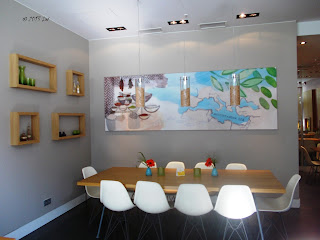The school vacations are over today - I am still not used with the idea of the kids going at school in August and how else one can celebrate the beginning of a new adventure than by going to visit the animals at the Zoo. To be honest, I prefer the other Zoo - Tierpark, from the former Eastern side of the city, as it is bigger and more spectacular, but for time reasons, the one who's closer from home was chosen. The Tierpark was built after the war as a way to counterbalance the loss of the Zoologische Garten, but after the reunification, the Cold War of the Zoos ended too.
At the entrance, long lines of people with or without children, but the lines are going fast and in less than 15 minutes we were on the other side of the Zoo Gate. During the week, including on holidays, it is less crowded. The last time I've been here was more than 4 years ago, but after I spent 5 hours without even noticing how fast the time flies away I took bake all my grumbling about this Zoo. It is interesting and I learned again some new things about animals and birds.
For instance, I did not know that the Poitou donkey exist. Apparently, if I understood correctly the explanation - most of the stories are written in German - it is one of the oldest type of donkey in Europe being on the continent since the 10th century, and as a type is placed somewhere in between horse and donkey. It looks funny and made the transition to the little farm, one of the most dynamic I've seen by far in Europe.

The animals are quite bold and not only wait in the front of the food machines to be given their little tasty presents, but they run and walk in the middle of the children and are allowing to be touched. At the Zoo, there are many regional German goose and ducks, but also a funny Hottentottenente. Although the wild animals and wolves seem to be more challenging, I spent some time at the house of birds: organized by continents, all of them are so colourful and interesting. Especially those from Latin America made me consider seriously going there for some direct experiences. And I also want to see live the Sumatra orang-outangs.

The disadvantage of visiting a Zoo on a hot day is that many of the animals, especially those from moderate/cold climates will rather prefer to hide. Most of the bears were like that and this funny one, was trying hardly to cope with the burning sun. The best for him was to swim, bear-style, the same choice for the hippos a couple of yards away. The icebear was not doing that great and was moving unhappy from a rock to another.
The best time to visit the Zoo with kids is around 11, when it starts usually the feeding time. The funniest part is at the monkeys' cages, but also the giraffes and elephants are interesting. Did not enjoy at all the bloody meals of lions and wolves though.
As flamingos are my no.1 birds, I was happy to see several members of the family, in cages or free. So much grace and elegance is hard to find anywhere else in the animal world. I wanted to stay more but of course, the monkeys are always the most-wanted characters so needed to leave. And somehow, the bonobos are always worth the interruption.
The Zoo also has an Aquarium, but I prefer that this time will not go, especially after so frequent visits at the one in London. I've found interesting that many - if not most - of the cages mention that the animals also have their own sponsor/caretaker, a person or family that takes care of them on a regular basis. According to the information provided at the cages, in the last 2-3 years, many baby animals were born at the Berlin Zoo, including a cute baby elephant, now already 1 year old, that yesterday was hiding shy under the legs of the mother.
A visit in the animal kingdom is refreshing and gives a lot of food for thought, but it is also relaxing, especially if you look and listen to the white cockatoos. I wish I had more time and more animals to see, but my plan is to go to the Leipzig Zoo and to Dresden, the oldest in Germany.





















































